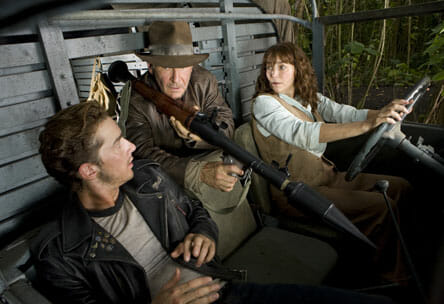
Release Date: May 22
Director: Steven Spielberg
Writer: David Koepp, (story by George Lucas and Jeff Nathanson) Cinematographer: Janusz Kaminski
Starring: Harrison Ford, Cate Blanchett, Karen Allen, Shia LaBeouf
Studio/Run Time: Paramount Pictures and Lucasfilm, 124 mins.
Indiana Jones has neither swashed nor buckled on the big screen in 19 years, but he’s back in Indiana Jones and the Kingdom of the Crystal Skull, which appropriately takes place 19 years after the last film. It’s now 1957, and Indy has aged along with his fans and, more importantly, the actor who plays him. But, aside from a couple of jokes about his age, you’d hardly know it. He still throws—and takes—more punches than the rest of the world’s archaeologists combined, but surprisingly, Harrison Ford, now 66, looks neither computer generated nor out of place in these fist fights. Whether it’s done with the latest technology or just fancy stunt work, the action in Crystal Skull has an almost antiquated realness, an art that I thought was lost in the embrace of CGI.
The film is fun, but it doesn’t hold a torch to the original. It’s too busy reconnecting severed ties and repeating our favorite bits, but it comes closer to capturing the magic of Raiders of the Lost Ark (1981) than the other sequels did, and parts of it are more thrilling than anything else in the entire series.
The plot involves an elongated crystal skull that looks like a glass rendering of Ridley Scott’s alien. Naturally, everyone wants it (wouldn’t you?), not because it looks like it’s filled with wads of useful cellophane but because whoever returns the skull to the temple from whence it came gets some sort of unimaginable reward, one that doesn’t seem to be monetary. The Soviets, like the Nazis who pursued the Ark of the Covenant in the first film, want the skull for nefarious purposes. Beyond this outline, the story is a tangle of barbed wire that hardly seems worth the bloody fingers it would take to straighten it, and screenwriter David Koepp doesn’t expect us to. Every once in a while someone sums everything up (“He’s telling us to look in Peru!”), and then the film dissolves to a map and follows a red line to an exotic new locale.
The red line starts at a warehouse in Roswell, New Mexico, dropping Indy into the nuclear age. In wide vistas, the low sun gives every gray cloud a thick orange outline, and the horizontal light makes every man, woman and polished fender seem to radiate with an interior glow. It’s a great look, which is probably why Spielberg and his director of photography, Janusz Kaminski, stick with it even when the film leaves the harsh Southwestern sun and moves to collegiate New England. Our heroes, with glowing hair and brightly lit temples, shine with a light that wouldn’t have been possible in the subterranean Temple of Doom. The Indy films were always best when their famous underground adventures were anchored by light, a lifeline which is either a few steps back or still overhead, streaming through a hole, lighting the staff of Ra, pointing the way from an opening that’s ever in danger of closing. The new film revels in that kind of crystalline vision. Kaminski pokes holes in the jungle canopy to let airy columns flood the subjects and let the action happen in full view. In the film’s centerpiece, a fantastic, absurd, high-speed chase through trees, Spielberg masterfully juggles five or six characters such that we always have a pretty good idea of who is where, even as they leap from vehicle to vehicle. This clarity seems to defy modern-action conventions that demand obscure, confusing visuals, and the result is thrilling.
Also great is Cate Blanchett as a tenacious, helmet-haired, thick-accented villain who makes her foes work for their gains. Shia Lebeouf plays a young tough who becomes Indy’s sidekick, but he stays mostly in the shadow of Dr. Jones, where he should be, providing welcome backup when called upon. And feeding the film’s potent sense of nostalgia is Karen Allen who reprises her role from Raiders, with more grins than booze.
Aside from the sustained invention of the jungle sequences, much of the movie feels like a recreation of something we’ve already seen, like the Vegas version of the Eiffel Tower. Half of the jokes fall flat, many of them dulled by sloppily—and it would seem unnecessarily—dubbed dialogue, and the closing credits appear gracelessly so that the film dribbles away without that big John Williams punch that even George Lucas knows to plug into the end of a Star Wars picture.
The film’s biggest gamble is its finale. Extraterrestrial wonderment has long been Spielberg’s trademark, but Indy’s close encounters risk cheapening a myth that usually has a more Earth-bound scale, just as Spielberg’s skinny aliens risked cheapening Kubrick’s A.I. Of course, the Jones myth already has a precedent for otherworldly objects (the Ark), so why sneer at the appearance of an actual UFO in The Crystal Skull? It’s pure Spielberg, and Lucas gets his own movie references: the film opens with a drag race straight out of American Graffiti, and in the climax, Indy steals Han Solo’s most famous line.
Which settles a longstanding dispute: Indiana Jones is a plunderer of buried artifacts after all.